Moira Butterfield's Blog, page 79
May 14, 2013
Keeping It In The Family - Lynne Garner
Recently my niece called me and asked if I'd be willing to be a sounding board for her final major project (a picture book) at University. Although students were permitted to illustrate a well known story she'd decided to write and illustrate her own picture book. Being the helpful aunt I agreed.
Our first step was for me to read her manuscript. It's a really sweet story and well written. However I made a few suggestions for tweaking. Well what did she expect? She had sent her manuscript to a creative writing teacher.
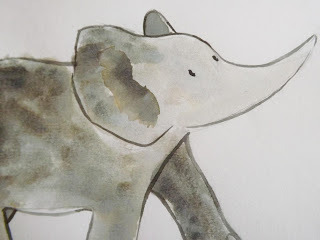 Her main character Tumo the baby elephant
Her main character Tumo the baby elephant
We set aside an afternoon for her to come over. She arrived with several A3 sketchbooks full of ideas. We soon realised we had some hard decisions to make. What to keep? What the tweak? What to kill?
It was decided the best course of action was to pick the ideas we both liked and stitch these together. Basically she started with page one and worked a page at a time.
When spreads 11 and 12 were reached that magic light bulb moment happened. She'd come up with such a lovely image for spread 11 that it cried out to become the final spread. So with a tweak in the wording version one was complete, with its new ending.
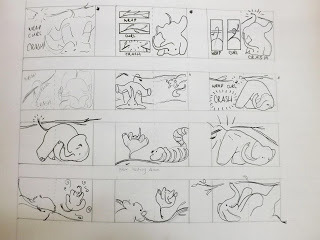 Some of my nieces quick sketches
Some of my nieces quick sketches
I've yet to see the completed story but I'm sure it will be worth the wait. I really enjoyed the process and hope perhaps once she's graduated we'll get the opportunity to work together. My words supported by her wonderful pictures, a real family affair.
Lynne GarnerI also blog on An Awfully Big Blog Adventure, Authors Electric, Fuelled By Hot Chocolate and The Hedgehog Shed
P.S.
Editors: If you're looking for a new writer/illustrator please contact me direct at lynne@lynnegarner.com and I'll put you in contact with my niece. It would be lovely to have another writer in the family!
P.P.S.
I teach two distance learning courses via Women On Writing which start 6th July - How To Write A Picture Book and Five Picture Books In Five Weeks.
Our first step was for me to read her manuscript. It's a really sweet story and well written. However I made a few suggestions for tweaking. Well what did she expect? She had sent her manuscript to a creative writing teacher.
 Her main character Tumo the baby elephant
Her main character Tumo the baby elephant We set aside an afternoon for her to come over. She arrived with several A3 sketchbooks full of ideas. We soon realised we had some hard decisions to make. What to keep? What the tweak? What to kill?
It was decided the best course of action was to pick the ideas we both liked and stitch these together. Basically she started with page one and worked a page at a time.
When spreads 11 and 12 were reached that magic light bulb moment happened. She'd come up with such a lovely image for spread 11 that it cried out to become the final spread. So with a tweak in the wording version one was complete, with its new ending.
 Some of my nieces quick sketches
Some of my nieces quick sketchesI've yet to see the completed story but I'm sure it will be worth the wait. I really enjoyed the process and hope perhaps once she's graduated we'll get the opportunity to work together. My words supported by her wonderful pictures, a real family affair.
Lynne GarnerI also blog on An Awfully Big Blog Adventure, Authors Electric, Fuelled By Hot Chocolate and The Hedgehog Shed
P.S.
Editors: If you're looking for a new writer/illustrator please contact me direct at lynne@lynnegarner.com and I'll put you in contact with my niece. It would be lovely to have another writer in the family!
P.P.S.
I teach two distance learning courses via Women On Writing which start 6th July - How To Write A Picture Book and Five Picture Books In Five Weeks.
Published on May 14, 2013 23:30
May 9, 2013
Yay! Shark Teeth! The pleasures of a picture book hobby, by Jane Clarke
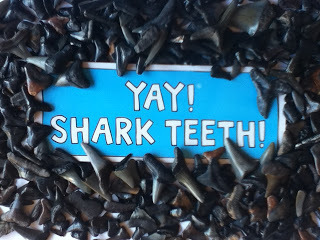
For as long as I can remember, I've collected fossils.
When we lived in the south of the Netherlands, the easiest fossils to find were the fossil sharks’ teeth that washed up on the seashore near Cadzand, Zeeland. Soon I had a collection of large-ish ones to put on the shelf behind the downstairs loo:
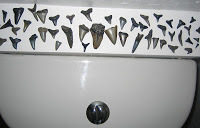
I found out a lot of cool facts about fossil sharks and sharks in general - for example, in a lifetime, a shark can get through more than 10,000 teeth. When I was thinking of a picture book story that required two inseparable friends, a great white shark and a remora were the first things that popped into my head. I was thrilled when my story was paired with Charles Fuge's wonderful illustrations.
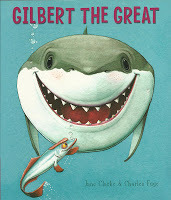
After I moved back to England, two more sharky stories came along:
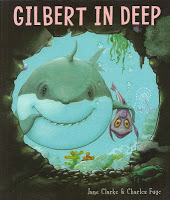
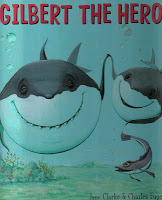
On my birthday, I was given a huge fossil tooth - no loo shelf for this one, it sits in pride of place on my desk.
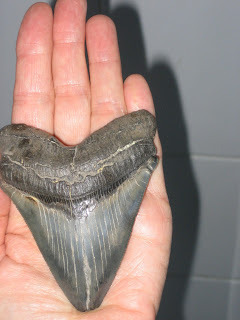
It was fabulous to discover that, in Florida, you can pick up fossil sharks' teeth on a warm sunny beach! Here’s a handful of small ones I found at Manasota Key, near Venice, Florida. They're great giveaways whenever I sign a Gilbert book.
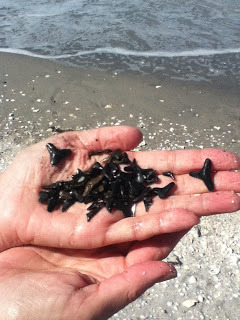
I've become a regular visitor to Florida, and I'm always discovering fake sharks and jaws you can stick your head in!
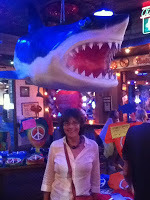
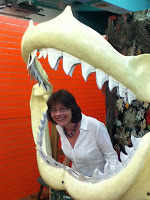
You can leap out of your canoe and pan for fossil sharks teeth on the bed of the Peace River,
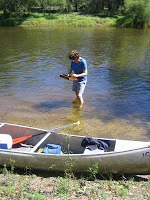
and follow that with key lime pie floating on streaks of raspberry blood and topped with a gummy shark at Sharky’s on the Pier, Venice FL!

Do picture book related hobbies get any better than this?
Jane's website
Jane's Facebook author page
Published on May 09, 2013 23:00
May 4, 2013
Writing can wait. On the death of my mum and her influence on me, creative and otherwise by Juliet Clare Bell
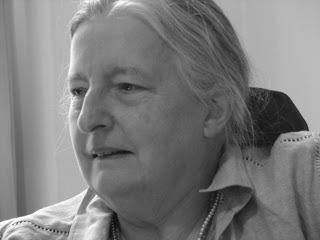
My mum, taken by my sister, Stella Bell.
Shortly after posting my last blog (and two days after we’d been chatting about it), my mum, Margaret Bell/Storr died very suddenly and completely unexpectedly. She was well and happy, but she’d broken her ankle five weeks before, and, unbeknownst to us all, she’d developed a blood clot which went very quickly to her lungs. She’d spent part of the morning with my dad and brother and part writing more of her work in progress, a middle grade novel about a girl in the Second World War –a version of which she’d emailed to me less than 24 hours before she died. She had been on a creative roll.
She’d always been creative. She drew, painted and wrote –stories for her students, to fit their level of English but also their level of interest and understanding; beautiful, often rhyming, notes to us when we were children; stories for her grandchildren, and for the past five years or so, she had been a fellow member of the SCBWI (Society of Children’s Book Writers and Illustrators). She was also writing short stories for adults and lots of poetry, both of which had had recent success.
As someone who relied on her sharp mind for writing, painting, reading and conversing, getting dementia (like her own mother) was her greatest fear. It is a real comfort that this never happened. As for breaking her ankle? Well, she couldn’t do the thing she hated –housework, but she could absolutely do the things she loved, whilst being looked after by family and friends: write, read, paint and spend time with people she loved. She sounded happier in the last five weeks than I can remember –ever.
It’s not a huge surprise I’ve ended up writing. My parents’ sharing of their love of stories started before birth for me. The Juliet in my name is straight from Shakespeare. After watching Zeffirelli’s Romeo and Juliet whilst heavily pregnant with me, they decided that if I were a girl, they’d call me Juliet rather than Clare as they had previously chosen. The fact that I came out looking more like a long, scrawny orang-utan than the beautiful Olivia Hussey led to the current confusion with my name (always called Clare but with a different first name...hmmmn ...
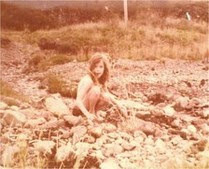
More a Clare than a Juliet?
and only my brilliantly bonkers Shakespearean-loving parents could have made the decision to name my eldest brother Andrew Michael Bell even though they were always going to use Michael because ‘if his initials had been MAB [rather than AMB], people would have teased him’ (because of the tiny midwife fairy, Queen Mab, spoken of by Mercutio, also in Romeo and Juliet...?!). Stories were central to their lives and ours.
They read and sang to us every night, were genuinely enthusiastic about our own writings and could quote reams of poetry and Shakespeare willy nilly. (As a teenager this could be excruciatingly embarrassing -my biggest teenage rebellion was to hate classical music and choose not to do English A Level. There wasn’t much else to rebel against. Either side of being a teenager, it was great.)
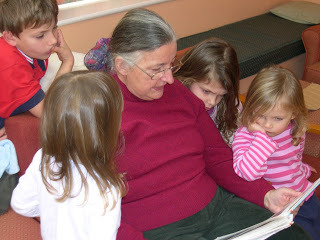
My mum never shied away from telling us sad stories. I particularly remember Orpheus and Eurydice, which I agonised over as a child, and also the story of Lot’s wife being turned into a pillar of salt, which I turned into a slightly odd, superstitious game on my way to school. And the songs they sung to us at night! ‘I heard the curlew crying far, but I never heard my baby-o...,’ or ‘Ah my Geordie will be hanged in the golden chains, 'tis not the chains of many...’ (and many other Joan Baez songs). The songs and the stories and the storytelling were beautiful. The language of sad is often extremely beautiful. And they instilled a love of language in us. For the Christmas before I turned six, they gave me The Green Children, written by Kevin Crossley-Holland and illustrated by Margaret Gordon, a really old East Anglian story.
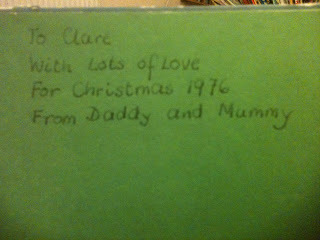
It’s sad. Very sad:
“One dark day, when the ground was like iron underfoot and the shifting skies were grey, the green boy threw up his hands and died.”
But they didn’t just give me the book. My mum sewed me Green Boy and Green Girl, which I still have now. And the dolls’ faces reflect the sad story. I cuddled them pretty much every night throughout my childhood as if I could somehow change the story and save Green Boy–which I did, for the doll at least. Green Girl and Green Boy are still alive and well thirty six years later (even if Green Boy’s tunic has recently been removed by a small child...).
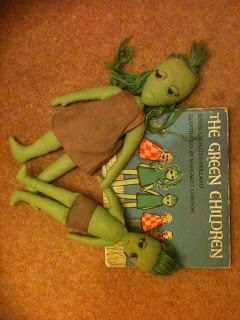
(You won’t see the pearl tears that she also sewed on to their faces, because I unpicked them when my own children were old enough to start asking questions about it...)
And of course it wasn’t just sad stories and songs–there were also a lot of funny and silly ones –and run-of-the-mill every day ones. But it’s the sad and the funny/silly ones that I’ve remembered the best over time.
So I grew up with stories and poems (and music and pictures) all around me. Some of my siblings were more taken by the music and the pictures, and I guess I’ve gravitated more towards the stories and writing. And I keep finding her inscriptions in the various books that I’ve naturally turned to for comfort in the last few weeks –including poetry, which we both loved. She may have died, but she’s certainly still around. And we’ll each find her in slightly different things and places...
But there’s something much bigger that my mum and dad gave me, the most important thing that any parent can give a child: unconditional love.

My mum and dad and me
Unconditional love from parents remains with you no matter where you go and what you do and its strength is immense. In my mid-twenties, I was attacked on my way home one night, and I was lucky to come out of it alive, and largely physically ok. Even when it was terrible, I still knew that I would get through it and that things would be great again –and that was from an unshakeable knowledge that I am completely loved by my parents. And it’s the same now –even when things feel almost unbearably sad as they sometimes do (or I’m just gutted that I can’t tell her something- like, that there’s a picture book of Pride and Prejudice out-with photos of knitted characters –which she’d have loved...
or that I’ve just received a Korean version of The Kite Princess in the post even though I didn’t know it had been translated...
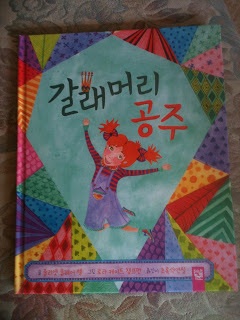
or that the forthcoming Taiwanese version of Don’t Panic Annika! that she periodically asked me about actually came out almost a year ago but the copies never arrived from Taiwan... or most of all, that my five-year-old, the youngest of all her grandchildren, has lost his first tooth, -I know that things will be great again and I will always have the most precious thing that my mum ever/always gave me: love. My mum doesn’t have to be here in person for this to affect everything that I do and the way I experience things. That bit doesn’t die. And it’ll pass down through the generations –through her six children and fifteen grandchildren, as we sing our own children to sleep with the songs she sang (the happier ones at least!), read to them, love them...
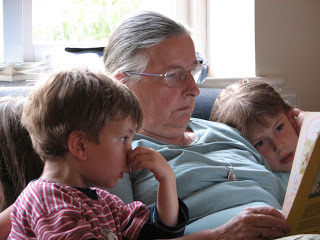
Our mum will help us get over her own death...
If you haven’t read Debi Gliori’s wonderful picture book, No Matter What, then you’re in for a treat when you do.
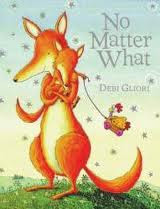
It’s about exactly that: the unconditional love of a parent for his or her child –even after death (you need to read the UK version rather than the US version which has all references to death removed). My mum really liked it, as did many of her children and grandchildren, and it felt completely appropriate to put a copy of the book in the grave with her. Our new copy has been read countless times by my children and me since she died. It’s a beautiful, comforting read. And the love that pours out of every word and brushstroke of that book is a lesson for all picture book authors and illustrators. It feels like she's captured the words of the Joan Baez song, East Virginia, (or The Aching Pains song to my family) which my parents loved, where Joan Baez sings:
"Just the thought of you, my darling,
sends aching pains all through my breast"
This is how my mum and dad described the feeling of overwhelming love for your children when you creep into the bedroom at night and watch them sleeping. It's so true.
I’ve not written or edited a single word of a story since March 12th. I have no appetite for it at all. It seems to belong to another time entirely. But I know that I’ll probably feel like it again at some stage. In the same way that I couldn’t read more than a couple of sentences for a whole year after I was attacked (I simply couldn’t remember the start of the sentence, let alone, the paragraph), and then I went back and finished the PhD I was writing, I am likely to find head space to write stories at some stage. Even writing this blog post has made it seem closer.
And when I do, I know there’ll be a little bit of my mum in it...
I want to end with Nat King Cole’s Nature Boy, with my favourite phrase in a song:
“The greatest thing you’ll ever learn is just to love, and be loved in return...”
I’ll be up in Orkney when this post comes up –with my dad and in the place my mum loved so much. We’ll sort out some paper work, work on setting up a project in my mum’s name, talk, cry, laugh, walk around some of her favourite places, and most of all, love –and be loved. The writing? As Abie showed in her recent blog post, that can wait.
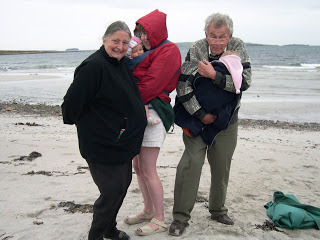
Us, freezing, but happy, on an Orkney beach in August (2004)
There’s a small PS. Since writing this blogpost (a couple of days in advance because I'm off to Orkney), I’ve actually written something for a story. Not much, and completely related to the events of the last two months, but the outline of a story, and some phrases –in one of my mum’s notebooks, alongside some of her own writing and notes from a conversation we had about doing writing workshops with children. There'll certainly be some aching pains in the writing of it, but I think it will be comforting, too -whether it stays as something just for me, or not. Cheers, Mum. x
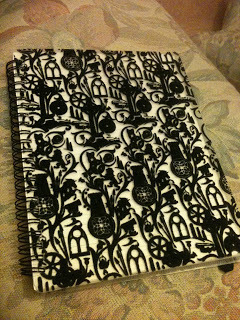
My mum's recently started notebook, which I'm now using as my own.
Juliet Clare Bell www.julietclarebell.com
Published on May 04, 2013 14:53
April 29, 2013
Competition winner - but is it ready for publication?
I was recently asked to look at a picture book text that had won a prize in a competition.
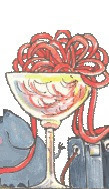 1st Prize The problem was that when it was sent out to editors it just came bouncing back, again and again. The writer was understandably concerned.
1st Prize The problem was that when it was sent out to editors it just came bouncing back, again and again. The writer was understandably concerned.
So what was wrong with it? I said I would look at it and see if there was an obvious problem, but I couldn't promise anything.
One of the problems with competitions is that they can raise expectations in unrealistic ways, often unintentionally. This might happen when the entrants and the judges are making widely differing assumptions about the end result.
e.g. Imagine you enter a competition that says 'Write a story for under 5 year olds in 750 words.'
Does that mean it is always a picture book text?If the rules do not specify this, then it could be a story in a different format, a poem, or a short story, and not necessarily a picture book. Does it mean that the story is ready and fit for publication? This is not necessarily the same thing as whether or not it is a well written or enjoyable story. As presented for the competition it may not have an obvious route to publication. The problem is whether the entrants understand that publication is a commercial decision based on a variety of factors i.e. in the right format, the right length and original enough, not solely on the merits of the actual story/writing. Does it mean the story is likely to be published?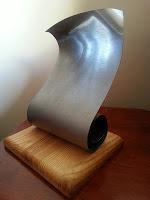 This is the tricky one. There is never a guarantee of publication for any story and for the reasons above it may not be right for publication. But, difficult as it is to admit, it might depend on the overall standard of entries to the competition, and whether the adjudicator has had to choose a winner out of the entries that were presented.It is an achievement to win a competition but, however wonderful, it is not a sure road to publication.
This is the tricky one. There is never a guarantee of publication for any story and for the reasons above it may not be right for publication. But, difficult as it is to admit, it might depend on the overall standard of entries to the competition, and whether the adjudicator has had to choose a winner out of the entries that were presented.It is an achievement to win a competition but, however wonderful, it is not a sure road to publication.
It is often easier looking at someone else's writing to spot the problems as it makes you analyse what makes a book work, and also what can go wrong. But I am always aware of how difficult it is to have someone read your work and tell you things are not right with it!
When I looked at this story I immediately saw that although it was an interesting idea and nicely written, there were several things that I felt were not working as a picture book. It felt more like a poem and I could see it was going to take quite a bit of (painful?) editing to make it work as a picture book.
Why was that?
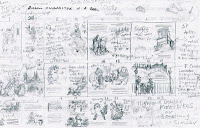 Hamish McHaggis © Sally J CollinsIf you read over some of the previous posts on Picturebook Den you will see how often people talk about the images, the importance of understanding how the words and the pictures work together over the 12 or 14 double page spreads. Even if you are not an illustrator, and most picture book authors are not, you need to visualise the story.
Hamish McHaggis © Sally J CollinsIf you read over some of the previous posts on Picturebook Den you will see how often people talk about the images, the importance of understanding how the words and the pictures work together over the 12 or 14 double page spreads. Even if you are not an illustrator, and most picture book authors are not, you need to visualise the story.
I found I had no sense of how this story would be told over the different spreads. This is not to say that I was looking to have it marked as 'spread 1' and 'spread 2' etc. But reading the text I felt that the writer had not 'seen' the story unfolding in her mind's eye. When I tried to imagine how it would look on the page I realised that too much of what was happening in the text would be the same visually, time after time.
The story was a lot of fun and had many different elements to it. There was counting, colours and lots of characters and in fact that was one of the problems. It had too much going on and most of it was repeated too often.
Repetition featured strongly in the actual words used, phrase by phrase, but each time it was almost exactly the same. In picture books every single word has to earn its place and repetition can work really well but it needs some variation within it, making it more interesting to read out loud. Or perhaps with a catch phrase that is repeated. Children love it when they can anticipate what is coming and can say it along with the person reading to them.
There were lots of characters (contributing to the counting and the colours) but they were all the same, no quirks or interesting features that would make me care about them, or what was happening to them.
The story was in rhyme and, as sometimes happens, it felt as if the story was being shaped by the rhyme rather than the rhyme enhancing the story. It is one reason why it is often better to try and avoid rhyme and concentrate on the rhythm.
The ending- This is such a crucial part of any picture book and often the most difficult part to get right. It sometimes helps to think about how you would describe the book to someone else. The writer needs to be able to say what the story is about.
If you are writing a novel you are sometimes asked to describe, in one or two sentences, the main theme of the novel. I think this can be applied to a picture book, too. By this I don't mean saying 'This is a counting book, or a book about colours.' It's about the emotional journey, what do the main character(s) learn in the book, what makes me care about them and does the story end in a satisfying manner?
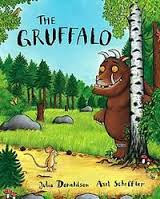
e.g. in the Gruffalo- A clever little mouse outwits the animals who want to eat him by persuading them he has a fearsome (imaginary?) friend. When the Gruffalo appears the mouse tricks him too, so that the Gruffalo ends up believing that the little mouse is truly the ' scariest creature in the woods'.
A picture book takes a child on a journey with the characters but there needs to be some kind of resolution that makes is feel there was a reason for the story to be told in the first place.
Reading all the changes I suggest, you might be led to think the original story was needing too much work. But I felt that it was a lovely idea that needed a bit of reshaping and a lot more visualisation before it could work as a picture book. The difficulty for the writer might be letting go of the original and taking a fresh look at it with images in mind.
There is never just one way to tell a story. Nothing is every wasted, it is amazing how often a story or idea can be changed, shuffled about and reshaped into something new, often even better.
Competitions are great for writers, in fact I got my first encouragement to start writing when I won a local library short story competition. Competitions give you a deadline and a challenge, and although they may not lead directly to publication they can help to take you another step closer.
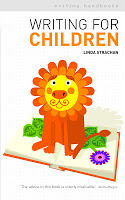
Linda Strachan is the award winning author of over 60 books for all ages, from picture books to teen novels, and writing handbook Writing For Children.
Website www.lindastrachan.com
Blog BOOKWORDS
 1st Prize The problem was that when it was sent out to editors it just came bouncing back, again and again. The writer was understandably concerned.
1st Prize The problem was that when it was sent out to editors it just came bouncing back, again and again. The writer was understandably concerned.So what was wrong with it? I said I would look at it and see if there was an obvious problem, but I couldn't promise anything.
One of the problems with competitions is that they can raise expectations in unrealistic ways, often unintentionally. This might happen when the entrants and the judges are making widely differing assumptions about the end result.
e.g. Imagine you enter a competition that says 'Write a story for under 5 year olds in 750 words.'
Does that mean it is always a picture book text?If the rules do not specify this, then it could be a story in a different format, a poem, or a short story, and not necessarily a picture book. Does it mean that the story is ready and fit for publication? This is not necessarily the same thing as whether or not it is a well written or enjoyable story. As presented for the competition it may not have an obvious route to publication. The problem is whether the entrants understand that publication is a commercial decision based on a variety of factors i.e. in the right format, the right length and original enough, not solely on the merits of the actual story/writing. Does it mean the story is likely to be published?
 This is the tricky one. There is never a guarantee of publication for any story and for the reasons above it may not be right for publication. But, difficult as it is to admit, it might depend on the overall standard of entries to the competition, and whether the adjudicator has had to choose a winner out of the entries that were presented.It is an achievement to win a competition but, however wonderful, it is not a sure road to publication.
This is the tricky one. There is never a guarantee of publication for any story and for the reasons above it may not be right for publication. But, difficult as it is to admit, it might depend on the overall standard of entries to the competition, and whether the adjudicator has had to choose a winner out of the entries that were presented.It is an achievement to win a competition but, however wonderful, it is not a sure road to publication.It is often easier looking at someone else's writing to spot the problems as it makes you analyse what makes a book work, and also what can go wrong. But I am always aware of how difficult it is to have someone read your work and tell you things are not right with it!
When I looked at this story I immediately saw that although it was an interesting idea and nicely written, there were several things that I felt were not working as a picture book. It felt more like a poem and I could see it was going to take quite a bit of (painful?) editing to make it work as a picture book.
Why was that?
 Hamish McHaggis © Sally J CollinsIf you read over some of the previous posts on Picturebook Den you will see how often people talk about the images, the importance of understanding how the words and the pictures work together over the 12 or 14 double page spreads. Even if you are not an illustrator, and most picture book authors are not, you need to visualise the story.
Hamish McHaggis © Sally J CollinsIf you read over some of the previous posts on Picturebook Den you will see how often people talk about the images, the importance of understanding how the words and the pictures work together over the 12 or 14 double page spreads. Even if you are not an illustrator, and most picture book authors are not, you need to visualise the story.I found I had no sense of how this story would be told over the different spreads. This is not to say that I was looking to have it marked as 'spread 1' and 'spread 2' etc. But reading the text I felt that the writer had not 'seen' the story unfolding in her mind's eye. When I tried to imagine how it would look on the page I realised that too much of what was happening in the text would be the same visually, time after time.
The story was a lot of fun and had many different elements to it. There was counting, colours and lots of characters and in fact that was one of the problems. It had too much going on and most of it was repeated too often.
Repetition featured strongly in the actual words used, phrase by phrase, but each time it was almost exactly the same. In picture books every single word has to earn its place and repetition can work really well but it needs some variation within it, making it more interesting to read out loud. Or perhaps with a catch phrase that is repeated. Children love it when they can anticipate what is coming and can say it along with the person reading to them.
There were lots of characters (contributing to the counting and the colours) but they were all the same, no quirks or interesting features that would make me care about them, or what was happening to them.
The story was in rhyme and, as sometimes happens, it felt as if the story was being shaped by the rhyme rather than the rhyme enhancing the story. It is one reason why it is often better to try and avoid rhyme and concentrate on the rhythm.
The ending- This is such a crucial part of any picture book and often the most difficult part to get right. It sometimes helps to think about how you would describe the book to someone else. The writer needs to be able to say what the story is about.
If you are writing a novel you are sometimes asked to describe, in one or two sentences, the main theme of the novel. I think this can be applied to a picture book, too. By this I don't mean saying 'This is a counting book, or a book about colours.' It's about the emotional journey, what do the main character(s) learn in the book, what makes me care about them and does the story end in a satisfying manner?

e.g. in the Gruffalo- A clever little mouse outwits the animals who want to eat him by persuading them he has a fearsome (imaginary?) friend. When the Gruffalo appears the mouse tricks him too, so that the Gruffalo ends up believing that the little mouse is truly the ' scariest creature in the woods'.
A picture book takes a child on a journey with the characters but there needs to be some kind of resolution that makes is feel there was a reason for the story to be told in the first place.
Reading all the changes I suggest, you might be led to think the original story was needing too much work. But I felt that it was a lovely idea that needed a bit of reshaping and a lot more visualisation before it could work as a picture book. The difficulty for the writer might be letting go of the original and taking a fresh look at it with images in mind.
There is never just one way to tell a story. Nothing is every wasted, it is amazing how often a story or idea can be changed, shuffled about and reshaped into something new, often even better.
Competitions are great for writers, in fact I got my first encouragement to start writing when I won a local library short story competition. Competitions give you a deadline and a challenge, and although they may not lead directly to publication they can help to take you another step closer.

Linda Strachan is the award winning author of over 60 books for all ages, from picture books to teen novels, and writing handbook Writing For Children.
Website www.lindastrachan.com
Blog BOOKWORDS
Published on April 29, 2013 17:00
April 24, 2013
Zen and the art of writing by Abie Longstaff
It's a funny business, this writing lark.
One moment you can be feeling low and convinced you'll never write again (see my previous, miserable post). The next moment you can be sitting on a fantastic new book deal (yay! More detail to come...)
I guess the trick (which I still haven't learned) is to simply enjoy the quiet periods: take some time off, see family and friends, play, draw, rest, shop - whatever your brain needs to recharge.
In my busy times I work hard. I write while juggling children and a day job, and my writing moments are snatched from my daily life. I write on the tube, in my lunch break, at gymnastics pick-up, in the queue at the supermarket; wherever I can. It's often frenetic; dashing home to scribble a plot down before I forget it, or getting up early to write character notes before I set off for work.
The last couple of months my work has been quieter. After the initial panic of eek! what shall I do? I settled into a slower routine. I started to play a bit more, draw a bit more and take longer over my plots and characters.
I've also caught up on all my boring admin,
been to France to visit my parents,
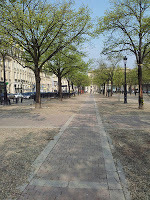
seen a wonderful exhibition of picture books,
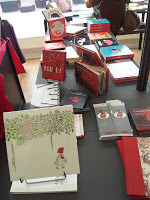
done lots of lovely walking,
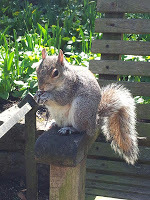
sketching,
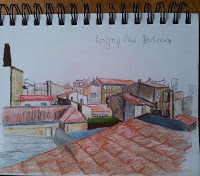
and spent proper time with the kids. All of which has helped me recharge ready for the frantic writing ahead.
It's reminded me of Jane's lovely post on composting
http://picturebookden.blogspot.co.uk/2013/03/ideas-composting-by-jane-clarke.html
where she wrote about taking the time to let ideas grow. All that time recharging has brought loads of ideas to the surface, ideas that are ready to grow into books.
Next time things are quiet, instead of panicking, I'm going to tell myself to enjoy the peace and use the time to recharge.
One moment you can be feeling low and convinced you'll never write again (see my previous, miserable post). The next moment you can be sitting on a fantastic new book deal (yay! More detail to come...)
I guess the trick (which I still haven't learned) is to simply enjoy the quiet periods: take some time off, see family and friends, play, draw, rest, shop - whatever your brain needs to recharge.
In my busy times I work hard. I write while juggling children and a day job, and my writing moments are snatched from my daily life. I write on the tube, in my lunch break, at gymnastics pick-up, in the queue at the supermarket; wherever I can. It's often frenetic; dashing home to scribble a plot down before I forget it, or getting up early to write character notes before I set off for work.
The last couple of months my work has been quieter. After the initial panic of eek! what shall I do? I settled into a slower routine. I started to play a bit more, draw a bit more and take longer over my plots and characters.
I've also caught up on all my boring admin,
been to France to visit my parents,

seen a wonderful exhibition of picture books,

done lots of lovely walking,

sketching,

and spent proper time with the kids. All of which has helped me recharge ready for the frantic writing ahead.
It's reminded me of Jane's lovely post on composting
http://picturebookden.blogspot.co.uk/2013/03/ideas-composting-by-jane-clarke.html
where she wrote about taking the time to let ideas grow. All that time recharging has brought loads of ideas to the surface, ideas that are ready to grow into books.
Next time things are quiet, instead of panicking, I'm going to tell myself to enjoy the peace and use the time to recharge.
Published on April 24, 2013 23:08
April 19, 2013
How do you present a picture book text to a publisher? By Ragnhild Scamell
My very first picture book submission was probably 2500 words long, and it was full of action. When the editor rang to say that they loved it, I was overjoyed. Yippee! A few weeks later, an envelope arrived, and inside was my story, stripped down to its bare bones. What? Where was all my clever stuff? In the gorgeous illustrations, of course, as I later discovered.
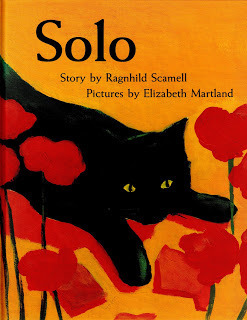 My second story was much more trimmed. I spent hours making sure that it was as short as I could make it, but it still came back heavily edited. ‘Sorry, the illustrations don’t allow much space,’ was my editor’s excuse. But when I saw the pleasing result in the finished picture book, I began to get the message. A picture book is a story visualized by three people: the writer, the editor and the illustrator. Being a quick learner, I now devised a system of twelve floating computer boxes into which I fitted my story. It took ages to do, but I was always happy with the final result before it went off. And I grew to accept that changes were inevitable, often to accommodate a particular illustrator’s style. But as I became more and more experienced, I also became less and less spontaneous. As I fiddled and fussed, I began to wonder: Do publishers actually want thoroughly honed stories? The editor will be looking for something new and exciting, and the story must first and foremost be capable of inspiring the illustrator, so that she can produce her best and most imaginative work.
My second story was much more trimmed. I spent hours making sure that it was as short as I could make it, but it still came back heavily edited. ‘Sorry, the illustrations don’t allow much space,’ was my editor’s excuse. But when I saw the pleasing result in the finished picture book, I began to get the message. A picture book is a story visualized by three people: the writer, the editor and the illustrator. Being a quick learner, I now devised a system of twelve floating computer boxes into which I fitted my story. It took ages to do, but I was always happy with the final result before it went off. And I grew to accept that changes were inevitable, often to accommodate a particular illustrator’s style. But as I became more and more experienced, I also became less and less spontaneous. As I fiddled and fussed, I began to wonder: Do publishers actually want thoroughly honed stories? The editor will be looking for something new and exciting, and the story must first and foremost be capable of inspiring the illustrator, so that she can produce her best and most imaginative work.
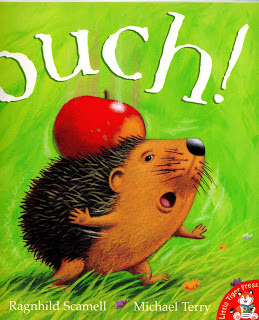 So, would it be better not to be quite so fussy when sending off a text and to leave a bit of the fun for the editor to edit and for the illustrator to be excited by? An editor once told me that they were happy to receive ideas which, together, we could turn into stories. I have never taken her up on that invitation, but it makes me wonder whether there isn’t something to be said for the style of my very first story. Do we take away some of the spontaneous fun by honing our stories too much and making them too thin? And are editors irritated by too many illustration notes? Do they cloud their vision? I asked some of the Picture Book Denners what they do: Abie Longstaff said: ‘Although I do not illustrate my books, I have studied illustration and I draw in my own time. Due to this the look of the book; the spreads, pacing and colour, is very high in my mind when I write. I always draw out full thumbnails for every book to help me get the delivery and speed right. I never send these to the publisher (they are just for me) but, because I have considered this angle, I do end up writing illustration notes. I know some publishers do not like this, but I have been lucky in that both of my main publishers are happy to have input and have included me at early stages of roughs or character designs. So, I send out my text in one document marking the page breaks for 13 spreads and one extra page. I include notes of the main relevant points for illustration (such as where I have set up a joke between the text/picture, or where I have saved words by putting something in the illustration instead of the text) but not real detail such as colours (unless particularly relevant). I put the notes in italics. I do a cover page with my name, my agent's name, word count and age range for the book. Sometimes I play with the text, setting out parts of it as a newspaper article, or making patterns with the words if these kind of things are relevant to the story.’ Pippa Goodharthas a different approach: ‘The simple, but not very useful, answer is that the text should be presented in whatever way will make the clearest read of the story, with pictures in mind, for a potential editor. I think that the best way to present a picture book text varies enormously according to the text and the story. Sometimes there is no need to specify anything about pictures because their content is obvious, and the treatment of that content is up to the illustrator. But sometimes there are parts of the story that I want shown in the illustrations, but which aren’t told in the text, so illustration notes are then necessary. I tend to put those notes in italics, and they may take the form of general notes before the story text begins (‘NB Scruffy is a toy rabbit, and the action takes place in a child’s bedroom’ kind of thing), or may be individual notes for each spread (‘The elephant is peeping out from behind the watering can; seen by us but not by Archie’, kind of thing). I play with different presentations, but at the moment am favouring having the story text in a colour distinct from the illustration notes. I want the editor to be able to read the text uninterrupted in order to really experience the qualities of the text, but to have the illustration notes handy in case he/she is wondering how things might look.’ Lynne Garner agrees: ‘I set mine out already broken down into the page spreads, sometimes with the odd illustration suggestion. That way my editor can see how I see the book flowing from one page to the next.’ Jane Clarke ‘I send my text in spreads and try not to put in notes to illustrators unless they’re absolutely necessary to make sense of the words.’ Malachy Doyle is very specific: 1. ‘Finished, and as close to perfect as you possibly can. 2. Less than 500 words. 3. Double spaced (or one and a half) 4. Set into a maximum of sixteen blocks of text. (preferably 12 to 14) 5. With illustration guidelines, if necessary. (keep them to a minimum). 6. Only rhyming if the story absolutely needs it (and you’re a brilliant rhymester). 7. There needs to be an ‘aah!’ page. 8. Finish with a smile.’ All are brilliant picture book writers, and the lesson I have drawn from this is that the more polished your story, the more chance you have of getting it published. Do you agree? I shall be most interested to hear what you do. And are there any editors or agents out there who would like to put their point of view? What do you want to see? Thank you very much indeed to everyone who contributed so generously to this blog. I couldn't have written it without you. Ragnhild Scamell writes picture books and early readerswww.ragnhildscamell.com
So, would it be better not to be quite so fussy when sending off a text and to leave a bit of the fun for the editor to edit and for the illustrator to be excited by? An editor once told me that they were happy to receive ideas which, together, we could turn into stories. I have never taken her up on that invitation, but it makes me wonder whether there isn’t something to be said for the style of my very first story. Do we take away some of the spontaneous fun by honing our stories too much and making them too thin? And are editors irritated by too many illustration notes? Do they cloud their vision? I asked some of the Picture Book Denners what they do: Abie Longstaff said: ‘Although I do not illustrate my books, I have studied illustration and I draw in my own time. Due to this the look of the book; the spreads, pacing and colour, is very high in my mind when I write. I always draw out full thumbnails for every book to help me get the delivery and speed right. I never send these to the publisher (they are just for me) but, because I have considered this angle, I do end up writing illustration notes. I know some publishers do not like this, but I have been lucky in that both of my main publishers are happy to have input and have included me at early stages of roughs or character designs. So, I send out my text in one document marking the page breaks for 13 spreads and one extra page. I include notes of the main relevant points for illustration (such as where I have set up a joke between the text/picture, or where I have saved words by putting something in the illustration instead of the text) but not real detail such as colours (unless particularly relevant). I put the notes in italics. I do a cover page with my name, my agent's name, word count and age range for the book. Sometimes I play with the text, setting out parts of it as a newspaper article, or making patterns with the words if these kind of things are relevant to the story.’ Pippa Goodharthas a different approach: ‘The simple, but not very useful, answer is that the text should be presented in whatever way will make the clearest read of the story, with pictures in mind, for a potential editor. I think that the best way to present a picture book text varies enormously according to the text and the story. Sometimes there is no need to specify anything about pictures because their content is obvious, and the treatment of that content is up to the illustrator. But sometimes there are parts of the story that I want shown in the illustrations, but which aren’t told in the text, so illustration notes are then necessary. I tend to put those notes in italics, and they may take the form of general notes before the story text begins (‘NB Scruffy is a toy rabbit, and the action takes place in a child’s bedroom’ kind of thing), or may be individual notes for each spread (‘The elephant is peeping out from behind the watering can; seen by us but not by Archie’, kind of thing). I play with different presentations, but at the moment am favouring having the story text in a colour distinct from the illustration notes. I want the editor to be able to read the text uninterrupted in order to really experience the qualities of the text, but to have the illustration notes handy in case he/she is wondering how things might look.’ Lynne Garner agrees: ‘I set mine out already broken down into the page spreads, sometimes with the odd illustration suggestion. That way my editor can see how I see the book flowing from one page to the next.’ Jane Clarke ‘I send my text in spreads and try not to put in notes to illustrators unless they’re absolutely necessary to make sense of the words.’ Malachy Doyle is very specific: 1. ‘Finished, and as close to perfect as you possibly can. 2. Less than 500 words. 3. Double spaced (or one and a half) 4. Set into a maximum of sixteen blocks of text. (preferably 12 to 14) 5. With illustration guidelines, if necessary. (keep them to a minimum). 6. Only rhyming if the story absolutely needs it (and you’re a brilliant rhymester). 7. There needs to be an ‘aah!’ page. 8. Finish with a smile.’ All are brilliant picture book writers, and the lesson I have drawn from this is that the more polished your story, the more chance you have of getting it published. Do you agree? I shall be most interested to hear what you do. And are there any editors or agents out there who would like to put their point of view? What do you want to see? Thank you very much indeed to everyone who contributed so generously to this blog. I couldn't have written it without you. Ragnhild Scamell writes picture books and early readerswww.ragnhildscamell.com
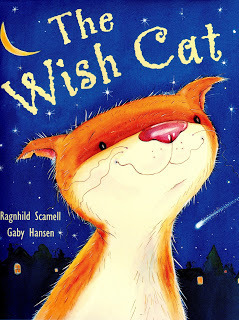
 My second story was much more trimmed. I spent hours making sure that it was as short as I could make it, but it still came back heavily edited. ‘Sorry, the illustrations don’t allow much space,’ was my editor’s excuse. But when I saw the pleasing result in the finished picture book, I began to get the message. A picture book is a story visualized by three people: the writer, the editor and the illustrator. Being a quick learner, I now devised a system of twelve floating computer boxes into which I fitted my story. It took ages to do, but I was always happy with the final result before it went off. And I grew to accept that changes were inevitable, often to accommodate a particular illustrator’s style. But as I became more and more experienced, I also became less and less spontaneous. As I fiddled and fussed, I began to wonder: Do publishers actually want thoroughly honed stories? The editor will be looking for something new and exciting, and the story must first and foremost be capable of inspiring the illustrator, so that she can produce her best and most imaginative work.
My second story was much more trimmed. I spent hours making sure that it was as short as I could make it, but it still came back heavily edited. ‘Sorry, the illustrations don’t allow much space,’ was my editor’s excuse. But when I saw the pleasing result in the finished picture book, I began to get the message. A picture book is a story visualized by three people: the writer, the editor and the illustrator. Being a quick learner, I now devised a system of twelve floating computer boxes into which I fitted my story. It took ages to do, but I was always happy with the final result before it went off. And I grew to accept that changes were inevitable, often to accommodate a particular illustrator’s style. But as I became more and more experienced, I also became less and less spontaneous. As I fiddled and fussed, I began to wonder: Do publishers actually want thoroughly honed stories? The editor will be looking for something new and exciting, and the story must first and foremost be capable of inspiring the illustrator, so that she can produce her best and most imaginative work.  So, would it be better not to be quite so fussy when sending off a text and to leave a bit of the fun for the editor to edit and for the illustrator to be excited by? An editor once told me that they were happy to receive ideas which, together, we could turn into stories. I have never taken her up on that invitation, but it makes me wonder whether there isn’t something to be said for the style of my very first story. Do we take away some of the spontaneous fun by honing our stories too much and making them too thin? And are editors irritated by too many illustration notes? Do they cloud their vision? I asked some of the Picture Book Denners what they do: Abie Longstaff said: ‘Although I do not illustrate my books, I have studied illustration and I draw in my own time. Due to this the look of the book; the spreads, pacing and colour, is very high in my mind when I write. I always draw out full thumbnails for every book to help me get the delivery and speed right. I never send these to the publisher (they are just for me) but, because I have considered this angle, I do end up writing illustration notes. I know some publishers do not like this, but I have been lucky in that both of my main publishers are happy to have input and have included me at early stages of roughs or character designs. So, I send out my text in one document marking the page breaks for 13 spreads and one extra page. I include notes of the main relevant points for illustration (such as where I have set up a joke between the text/picture, or where I have saved words by putting something in the illustration instead of the text) but not real detail such as colours (unless particularly relevant). I put the notes in italics. I do a cover page with my name, my agent's name, word count and age range for the book. Sometimes I play with the text, setting out parts of it as a newspaper article, or making patterns with the words if these kind of things are relevant to the story.’ Pippa Goodharthas a different approach: ‘The simple, but not very useful, answer is that the text should be presented in whatever way will make the clearest read of the story, with pictures in mind, for a potential editor. I think that the best way to present a picture book text varies enormously according to the text and the story. Sometimes there is no need to specify anything about pictures because their content is obvious, and the treatment of that content is up to the illustrator. But sometimes there are parts of the story that I want shown in the illustrations, but which aren’t told in the text, so illustration notes are then necessary. I tend to put those notes in italics, and they may take the form of general notes before the story text begins (‘NB Scruffy is a toy rabbit, and the action takes place in a child’s bedroom’ kind of thing), or may be individual notes for each spread (‘The elephant is peeping out from behind the watering can; seen by us but not by Archie’, kind of thing). I play with different presentations, but at the moment am favouring having the story text in a colour distinct from the illustration notes. I want the editor to be able to read the text uninterrupted in order to really experience the qualities of the text, but to have the illustration notes handy in case he/she is wondering how things might look.’ Lynne Garner agrees: ‘I set mine out already broken down into the page spreads, sometimes with the odd illustration suggestion. That way my editor can see how I see the book flowing from one page to the next.’ Jane Clarke ‘I send my text in spreads and try not to put in notes to illustrators unless they’re absolutely necessary to make sense of the words.’ Malachy Doyle is very specific: 1. ‘Finished, and as close to perfect as you possibly can. 2. Less than 500 words. 3. Double spaced (or one and a half) 4. Set into a maximum of sixteen blocks of text. (preferably 12 to 14) 5. With illustration guidelines, if necessary. (keep them to a minimum). 6. Only rhyming if the story absolutely needs it (and you’re a brilliant rhymester). 7. There needs to be an ‘aah!’ page. 8. Finish with a smile.’ All are brilliant picture book writers, and the lesson I have drawn from this is that the more polished your story, the more chance you have of getting it published. Do you agree? I shall be most interested to hear what you do. And are there any editors or agents out there who would like to put their point of view? What do you want to see? Thank you very much indeed to everyone who contributed so generously to this blog. I couldn't have written it without you. Ragnhild Scamell writes picture books and early readerswww.ragnhildscamell.com
So, would it be better not to be quite so fussy when sending off a text and to leave a bit of the fun for the editor to edit and for the illustrator to be excited by? An editor once told me that they were happy to receive ideas which, together, we could turn into stories. I have never taken her up on that invitation, but it makes me wonder whether there isn’t something to be said for the style of my very first story. Do we take away some of the spontaneous fun by honing our stories too much and making them too thin? And are editors irritated by too many illustration notes? Do they cloud their vision? I asked some of the Picture Book Denners what they do: Abie Longstaff said: ‘Although I do not illustrate my books, I have studied illustration and I draw in my own time. Due to this the look of the book; the spreads, pacing and colour, is very high in my mind when I write. I always draw out full thumbnails for every book to help me get the delivery and speed right. I never send these to the publisher (they are just for me) but, because I have considered this angle, I do end up writing illustration notes. I know some publishers do not like this, but I have been lucky in that both of my main publishers are happy to have input and have included me at early stages of roughs or character designs. So, I send out my text in one document marking the page breaks for 13 spreads and one extra page. I include notes of the main relevant points for illustration (such as where I have set up a joke between the text/picture, or where I have saved words by putting something in the illustration instead of the text) but not real detail such as colours (unless particularly relevant). I put the notes in italics. I do a cover page with my name, my agent's name, word count and age range for the book. Sometimes I play with the text, setting out parts of it as a newspaper article, or making patterns with the words if these kind of things are relevant to the story.’ Pippa Goodharthas a different approach: ‘The simple, but not very useful, answer is that the text should be presented in whatever way will make the clearest read of the story, with pictures in mind, for a potential editor. I think that the best way to present a picture book text varies enormously according to the text and the story. Sometimes there is no need to specify anything about pictures because their content is obvious, and the treatment of that content is up to the illustrator. But sometimes there are parts of the story that I want shown in the illustrations, but which aren’t told in the text, so illustration notes are then necessary. I tend to put those notes in italics, and they may take the form of general notes before the story text begins (‘NB Scruffy is a toy rabbit, and the action takes place in a child’s bedroom’ kind of thing), or may be individual notes for each spread (‘The elephant is peeping out from behind the watering can; seen by us but not by Archie’, kind of thing). I play with different presentations, but at the moment am favouring having the story text in a colour distinct from the illustration notes. I want the editor to be able to read the text uninterrupted in order to really experience the qualities of the text, but to have the illustration notes handy in case he/she is wondering how things might look.’ Lynne Garner agrees: ‘I set mine out already broken down into the page spreads, sometimes with the odd illustration suggestion. That way my editor can see how I see the book flowing from one page to the next.’ Jane Clarke ‘I send my text in spreads and try not to put in notes to illustrators unless they’re absolutely necessary to make sense of the words.’ Malachy Doyle is very specific: 1. ‘Finished, and as close to perfect as you possibly can. 2. Less than 500 words. 3. Double spaced (or one and a half) 4. Set into a maximum of sixteen blocks of text. (preferably 12 to 14) 5. With illustration guidelines, if necessary. (keep them to a minimum). 6. Only rhyming if the story absolutely needs it (and you’re a brilliant rhymester). 7. There needs to be an ‘aah!’ page. 8. Finish with a smile.’ All are brilliant picture book writers, and the lesson I have drawn from this is that the more polished your story, the more chance you have of getting it published. Do you agree? I shall be most interested to hear what you do. And are there any editors or agents out there who would like to put their point of view? What do you want to see? Thank you very much indeed to everyone who contributed so generously to this blog. I couldn't have written it without you. Ragnhild Scamell writes picture books and early readerswww.ragnhildscamell.com 
Published on April 19, 2013 23:00
April 14, 2013
The 'Small Bear' Challenge, by Pippa Goodhart
After blithely saying in a comment on Jonathan Allen’s wonderful blog last week that I’d love to write a story for his Small Bear character, I got thinking. It was easy enough to say that I’d like to do a story about Small Bear, but could I actually do it? In my picture books I’ve always created the characters in words first, and then they have been passed to an illustrator to be brought to visual life. The only times I’ve taken a picture of a character, and then worked stories for that character have been when writing the Winnie the Witch story books; never for picture books. So I thought I’d have a go. Here is the all-important Small Bear.
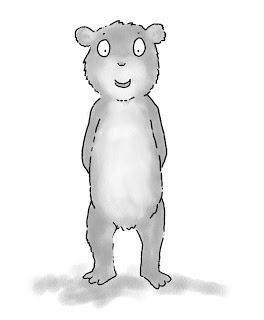
When working in my usual way I don’t think through my own thinking processes at all; I just DO it, and then try and work out how to make the story and text better. But I thought it might be interesting to chart something of my own thoughts as I set myself the task of writing a picture book story about that Small Bear. So here goes –
Thoughts:
What do I know about Small Bear from the picture of her?
She (no idea why, but she’s a ‘she’ in my mind even though, to others who commented on the blog, she was a ‘he’) is defined as being ‘small’. Is she perhaps small in relation to other bears? Or to a task she’s been given? Is her size problem or an asset, or both or neither?
She is boggle-eyed with something – naivity, amazement, fear, eagerness, hope, embarrassment? And she’s got her mouth open, so she’s telling us something, or asking for something, or singing, possibly? Her stance, hands behind back, suggests that maybe she’s self-conscious and addressing some authority figure. Performing? Or eager to please? Perhaps she has been naughty (small children DO love a story in which somebody is naughty!) and is making excuses whilst trying to look extra-good? Or are her hands behind her back because she’s hiding something out of our view? I showed the picture of Small Bear to one of my daughters, who immediately said, “She’s saying, ‘Guess what?’”. So now I’ve got a Small Bear voice developing in my head.
I like the picture of Small Bear being monochrome. Perhaps that could be kept, having Small Bear in monochrome as she stands and tells us whatever she has to tell, whilst behind her all the action of what she’s telling is in full colour? (I am no artist, but I can’t help thinking pictures and design as part of the process of working out story and words, even though the pictures and design will be decided about and executed by others, if it ever becomes a book.) To me, that monochrome against colour suggests storytelling by Small Bear.
I need a story topic for Small Bear which will resonate with a young child audience, and preferably also with the adults who will read the story to the child. Maybe Small Bear is a child’s teddy bear who is ‘real’? Ah, but that would involve human characters, and publishers prefer all-animal casts of characters for picture books. Could she be the smallest sibling in a big family, struggling to keep up with the others in a ‘wait for me!’ kind of way? Maybe she’s left with a strange babysitter, or at a house she doesn’t know? Or perhaps she gets lost from the company of just one parental kind of bear? Perhaps she thinks that HE is lost, rather than her? On a picnic? We all know that bears love picnics!
How can this stirrings of a story idea be told in an exciting and attractive way?
Since Small Bear is facing us, so perhaps there could be a dramatic tension in Small Bear being an unreliable narrator; she’s telling us some things that we can see for ourselves in the pictures aren’t actually what she has supposed they were. Perhaps use something like the Rosie’s Walk trick where the main character walks along without noticing moments of impending danger and lucky escape that we can enjoy in the pictures, so that we know more than her, even though it’s her telling a story about herself? Maybe use visual, rather than verbal, storytelling further … in the form that small children meet in the very first reading books which offer a series of pictures to be ‘read’ with no text? Perhaps like the wonderful outpouring of Penguin in Polly Dunbar’s picture book? That would give a whole chunk of story, or whole other story, that a child could access for themselves without adult help.
Make the story that Small Bear is telling catch-up with itself, coming together at the end into real ‘now’ time so as to make the whole thing feel more immediate than it would if it was all a retelling of something that is already over and done with.
I want some adventure and surprises, and some jokes too. How can this be done simply, using words and pictures playing games together? At the same time as showing Small Bear getting it wrong, can I make small readers themselves get it wrong in hinting at some menace coming? Then release that tension happily … with the ‘monster’ that’s chasing Small Bear turning out to be the parent bear?
If Small Bear is addressing us, then who are ‘we’? Hmm.
Please read the following story text critically, and then leave comments. I really want to know what does or doesn’t work. This is an experiment, and my hope is to get some really useful feedback out of it, and perhaps some discussion back and forth, so don’t hold back!
Small Bear’s Story (for a start, I probably need a better title!)
Illustration notes:
Small Bear is facing us, depicted in black and white (as in the sample picture), telling us her story. That story, in full colour, fills the spread behind her. We can see what she can’t; that things aren’t always quite what she’d supposed. When Big Bear returns and Small Bear’s story is brought up to the present, Small Bear joins the main picture in colour. Then we swap to both bears being in black and white whilst the main space is given over to Big Bear’s visual story bubble at the end.
Some spreads might show a series of images, others a single one.
Endpapers show a map of the jungle/forest, but also showing the Bears’ home, and the Lost and Found office which, we’ll realise, is where ‘we’ are, and to whom Small Bear is telling his tale.
Title page includes a vignette of Small Bear, as in sample picture, saying ‘Guess what?’ (Maybe that should be the title? Right, I’ll shut up now, and you think your own thoughts about what follows!)
1
I said could we have a picnic and Big Bear said yes if I was good, and I WAS good, so I put honey and bread and bananas in my basket, and Big Bear put a rug and juice in his, and then we walked into the wild place …
2
…and Big Bear said take care because I don’t want you getting lost, and I WAS taking care but my paws had things to do so I didn’t hold his paw, and then I saw some flowers…
(Got Tiny Bear (his teddy bear) in one paw, and the small covered basket in the other)
3
… - THESE flowers - , and I picked them as a present for Big Bear, and after that …
(In the coloured story being told, Small Bear has put down Tiny Bear and the basket in order to pick flowers, and after this he will have the flowers in one hand and the basket in the other, so doesn’t notice that he’s left Tiny Bear behind. Monochrome Small Bear telling us the story has produced the flowers from behind her back to show us as she tells the story of when she got them. They will eventually be, rather wilted, decorating Big Bear in some way at the end)
4
…Big Bear wasn’t THERE!
(Small Bear in the forest with no sign of Big Bear, who has walked on without her.)
5
I shouted for him, Big Bear, Big Bear where are you, but I think Big Bear is lost because he wasn’t there at all, and then I thought that I might get lost too if I stayed there because Big Bear is a bigger bear to lose than I am and HE got lost there, so I sort-of hummed to be brave and I ran….
(She’s disturbed a nest of bees with her basket hitting a tree, and her shouting is disturbing monkeys picking fruit in the tree. It’s the bees who are really humming)
6
…and ran….
(She’s being chased by the bees, although she doesn’t know it, but the monkeys in the trees have seen the danger for her and are following, swinging through the trees after the Small Bear and the bees. They are collecting fruit as they go)
7
… until I fell and hurt my knee….See? … and then I saw …
(Storyteller Small Bear is showing us her hurt knee. In the coloured story picture a monkey with a twig has deliberately tripped Small Bear, just as the bees were about to surround her. She’s falling, and so is the basket. Out of it fall the pot of honey and the bananas, with other monkeys taking them. In the next picture we see that a clever monkey has unscrewed the honey pot and left it as a distraction for the bees, and another has swapped his tree fruit for the bananas)
8
…something hairy and stary in the water, and I thought I bet that’s the monster that GETS YOU LOST and I didn’t want to get lost like Big Bear, and then I dropped my basket and IT was about to be lost, but it had our tea in it so ….
(Getting up after the fall, Small Bear is close to a river, and what she’s seeing is a reflection of her own face in it. We can see a crocodile noticing her, but she hasn’t noticed it. There’s an elephant drinking on the bank.)
9
… I had to go in the river to get it and I can’t swim so I …
(She’s saving the basket by throwing herself into the river, and the crocodile is very pleased and opening his toothy jaws to snap her, although she’s still not noticed. The elephant has seen what’s happening, and is reaching out her trunk, which Small Bear takes to be a tree branch. Also in the pictures, but unnoticed by Small Bear, are the fish who are now in the basket. The elephant takes the bread that was floating away.)
10
… held on to a tree thing and got me over the water and then…
(Crocodile snapping, but missing Small Bear who is being swept across the river by Elephant. Big Bear, when he tells/shows his story at the end, is going to be seen to have had to build a bridge over that water, and that slowed him down in getting to Small Bear who is still, unknown to her, running away from him. We’ll see that Big Bear’s bridge didn’t hold him, and he fell into the water and wrestled with the crocodile, tying his jaws together, so he’s sopping wet when he appears)
11
…I SAW the monster and it was a GINORMOUS Great Big skinny monster really really near me, so I ran…
(It’s evening now, and Small Bear is being scared by her own elongated shadow that is raising its arms in a menacing way, just as Small Bear raises her arms in dismay at what she sees. Distant thumping sounds evident)
12
…all the way here so please can you found Big Bear for me before … Uh-oh!
Thump thump THUMP THUMP! (Sounds coming nearer. These thumping sounds have been there, faintly, in previous spreads, growing in prominence in terms of size and boldness. Perhaps we can see a label making clear that Small Bear is now at the Lost And Foundoffice.)
13
Small Bear speech bubble: “BIG BEAR! They DID found you?! Can we have our picnic now?”
Big Bear speech bubble: “There there, Small Bear, here I am, found. And here’s you, safe and sound. But I don’t think that our picnic ….”
(Big Bear, who has seen the bees with the honey, monkeys with the bananas and elephant eating the bread en-route, supposes there is no food now in Small Bear’s basket. But he’s about to get a surprise….)
14
Big Bear speech bubble: “Well, however did THAT happen?!”
(Both bears looking in astonishment at the fish and fruit in Small Bear’s basket as Small Bear opens its lid)
15
Then Big Bear told HIS story.
( Big Bear has a huge speech bubble that is full of pictorial depictions of what happened to him…. realising that Small Bear has gone, finding Tiny Bear, seeing Small Bear’s paw prints etc. He kept almost catching-up with Small Bear, but missing because Small Bear was getting away so fast and with help from the elephant etc.
Perhaps, at this point, Big Bear and Small Bear should be seen in sepia/black and white, and just the pictorial content of his big speech bubble be in colour? We can see that Small Bear has given Big Bear the flower that she had stopped to pick. It’s a big crumpled and wilted. Small Bear is now fast asleep in Big Bear’s arms, taking no notice of his story, and he is addressing us, just as Small Bear had been before. )
Goodnight.
Published on April 14, 2013 16:30
April 10, 2013
Typically, how many words in a picture book? by Paeony Lewis
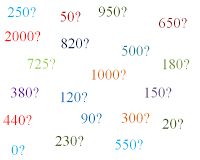 New writers often ask how many words they’re allowed in a picture-book text. The answer is as many words as are needed. Ho hum, when you’re new, that’s a frustrating answer. A more helpful answer might be to say that 500 words is a good general number.
New writers often ask how many words they’re allowed in a picture-book text. The answer is as many words as are needed. Ho hum, when you’re new, that’s a frustrating answer. A more helpful answer might be to say that 500 words is a good general number.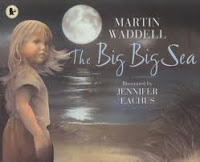 At this point somebody often says they've written a story that’s 1,000 or 2,000 words, and every word is needed. They'll also say they've seen picture books with over 1,000 words (the picture-book market teems with exceptions). So I'll bring their attention to Martin Waddell’s wonderful
Big Big Sea
(well, I think it’s wonderful, but picture-book readers also teem with exceptions!). I remember reading that the
Big Big Sea
started off at over 1,000 words, but when Martin Waddell searched for what was at the heart of his timeless story, the word count was reduced to 222 words (and that includes what could be considered an overlong ending). So don’t be afraid to be savage. You can save endless versions (I date them), so nothing is lost. Even so, I know cutting beloved words can be difficult.
At this point somebody often says they've written a story that’s 1,000 or 2,000 words, and every word is needed. They'll also say they've seen picture books with over 1,000 words (the picture-book market teems with exceptions). So I'll bring their attention to Martin Waddell’s wonderful
Big Big Sea
(well, I think it’s wonderful, but picture-book readers also teem with exceptions!). I remember reading that the
Big Big Sea
started off at over 1,000 words, but when Martin Waddell searched for what was at the heart of his timeless story, the word count was reduced to 222 words (and that includes what could be considered an overlong ending). So don’t be afraid to be savage. You can save endless versions (I date them), so nothing is lost. Even so, I know cutting beloved words can be difficult.I’ll admit I once wrote a picture-book text that was 1,700 words. Yikes! Despite my ludicrous wordiness, I received many lovely comments from publishers and a few suggested shortening the story. However, surprise, surprise, nobody took it on at 1700 words. Later I cut it to about 1,000 words. Still no takers and although I'm usually very flexible, I just didn't want to shorten it further so the story was stuck in a file to moulder. Years later I became interested in poetry and without looking at the original wording I rewrote the story in a poetic form. It became 374 words. My agent was enthusiastic. I’d like to be able to say it then sold, but it’s early days and I've no idea what’s happening. We'll see!
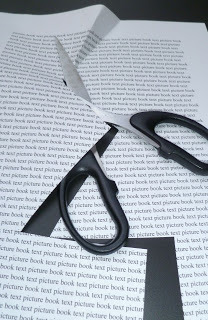 This experience gave me an idea for a writing exercise on a course I tutor on writing picture books. Some of you might like to try it. The students handed in their texts of 500 words (some tried to sneak in more words!). I then asked them to write a new version of their story in approximately 150 words, without access to the original story. They had to do it in class, and several were appalled at my cruelty. However, by the time they’d all finished, I was relieved and smug that it had been a revelation for them and they all felt their original stories could be cut and improved.
This experience gave me an idea for a writing exercise on a course I tutor on writing picture books. Some of you might like to try it. The students handed in their texts of 500 words (some tried to sneak in more words!). I then asked them to write a new version of their story in approximately 150 words, without access to the original story. They had to do it in class, and several were appalled at my cruelty. However, by the time they’d all finished, I was relieved and smug that it had been a revelation for them and they all felt their original stories could be cut and improved. Now here’s the really tricky bit. How far should you go when cutting a story? How far before just a shell is left and the vitality and sense of a story is lost? I once sold a story to a publisher and at the editor’s request I cut the 600+ word story until she was happy with what became a story of 500 words. Much later, a senior editor worked with me again on the story and asked me to expand several sections. These were the same sections I’d cut for the other editor! When I mentioned this she told me a story is as long as it needs to be . So we're back to the answer I said would frustrate new writers, but it's true!
If you've had success with increasing or decreasing the word count of a picture book, do share in the comments section. I usually start long and then cut and cut. Good luck.
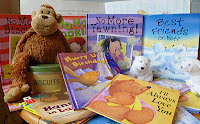 This blog post is by Paeony Lewis
This blog post is by Paeony Lewiswww.paeonylewis.com
Published on April 10, 2013 00:00
April 5, 2013
Editors: 10 Top Tips For Getting the Best From Your Contributors
By Moira Butterfield
I have been thinking recently about the delicate balance that exists in the relationship between an editor and freelancer. Having been both an editor and an author, I know there is a trade-off between meeting the needs of the company and its sales targets, and keeping contributors engaged and committed and generally ‘onside’. But what constitutes good and bad practice? Below is my list (in no particular order) of suggestions to smooth the relationship. If you are a freelancer, please add your own thoughts and experiences and it would be great to hear from some editors, too.
1. Don’t treat an author’s text as your own. Don’t try to re-write it wholesale. Good authors spend a lot of time choosing the right vocabulary and establishing the right rhythm. Many inexperienced editors don’t realise this and tamper with text too much. Suggest improvements by all means, but let the author convert suggestions into text.
2. Don’t ask your author to make changes without carefully explaining why. This may seem obvious but surprisingly it happens a lot. It isn’t about being above criticism. An author needs to know that the editor is clear about the direction of a project. There’s nothing worse than “Hmm. It’s not right yet,. I don’t know why….Can you sort it out?”
3. If you have a brief or some comments on work, email them over but also make sure you explain properly what you mean. Emails are notoriously bad communication tools. People take them to mean one thing when they mean another. Better to email, then phone.
4. Constant phoning with thoughts and requests isn’t great, either. Not only is it time-consuming, but the freelancer is going to feel that the editor doesn’t quite know what they are doing.
5. I have been to lots of sales conferences in the past, and salespeople often suggest useful improvements to proposed new projects but they have occasionally been known to spout ill thought-out nonsense, too. Good editors can sort the wheat from the chaff and gently but firmly head off the less considered comments. Don’t pass on all comments wholesale to the author and expect them to act on all of them. If there are consequences – a change of schedule or a lot of rewriting – it needs pointing out in-house.
6. If there are changes to be made, is it a rebrief on your part? Did you ask for one type of text and now you’re asking for another? Don’t pretend it’s not a rebrief when it is. If it is, you should allow for more time, and if appropriate, some recompense.
7. Freelancers are not employees. They need to be properly paid for their time and expertise, and treated with respect. See Point 6 above.
8. Keep your contributors in the loop about what’s going on in-house – If there’s been a delay or a postponement, for example. Silence is the worst option.
9. It takes surprisingly little to make a freelancer love you forever. ‘Thank you’ is good. Thank a freelancer immediately for work sent, even though you may not have had time to read it yet.
10. Tell your authors and illustrators what kind of projects your company is looking for, perhaps in the light of bookfair or sales team feedback. Your contributors are creative thinkers and, given the chance, they are likely to produce the goods.
Keeping the balance right is a difficult skill, requiring fine judgment and good people-handling skills. The payback for a good editor is in creating a good pool of creative talented people who are always keen to work for you.
One other thing. Get out of the office once in a while. Come and have a chinwag, a cuppa and a bun. Then you really will have your freelancer eating out of your hand!
PS: It would great to post a similar list from an editor regarding contributors. Do get in touch, editors.
I have been thinking recently about the delicate balance that exists in the relationship between an editor and freelancer. Having been both an editor and an author, I know there is a trade-off between meeting the needs of the company and its sales targets, and keeping contributors engaged and committed and generally ‘onside’. But what constitutes good and bad practice? Below is my list (in no particular order) of suggestions to smooth the relationship. If you are a freelancer, please add your own thoughts and experiences and it would be great to hear from some editors, too.
1. Don’t treat an author’s text as your own. Don’t try to re-write it wholesale. Good authors spend a lot of time choosing the right vocabulary and establishing the right rhythm. Many inexperienced editors don’t realise this and tamper with text too much. Suggest improvements by all means, but let the author convert suggestions into text.
2. Don’t ask your author to make changes without carefully explaining why. This may seem obvious but surprisingly it happens a lot. It isn’t about being above criticism. An author needs to know that the editor is clear about the direction of a project. There’s nothing worse than “Hmm. It’s not right yet,. I don’t know why….Can you sort it out?”
3. If you have a brief or some comments on work, email them over but also make sure you explain properly what you mean. Emails are notoriously bad communication tools. People take them to mean one thing when they mean another. Better to email, then phone.
4. Constant phoning with thoughts and requests isn’t great, either. Not only is it time-consuming, but the freelancer is going to feel that the editor doesn’t quite know what they are doing.
5. I have been to lots of sales conferences in the past, and salespeople often suggest useful improvements to proposed new projects but they have occasionally been known to spout ill thought-out nonsense, too. Good editors can sort the wheat from the chaff and gently but firmly head off the less considered comments. Don’t pass on all comments wholesale to the author and expect them to act on all of them. If there are consequences – a change of schedule or a lot of rewriting – it needs pointing out in-house.
6. If there are changes to be made, is it a rebrief on your part? Did you ask for one type of text and now you’re asking for another? Don’t pretend it’s not a rebrief when it is. If it is, you should allow for more time, and if appropriate, some recompense.
7. Freelancers are not employees. They need to be properly paid for their time and expertise, and treated with respect. See Point 6 above.
8. Keep your contributors in the loop about what’s going on in-house – If there’s been a delay or a postponement, for example. Silence is the worst option.
9. It takes surprisingly little to make a freelancer love you forever. ‘Thank you’ is good. Thank a freelancer immediately for work sent, even though you may not have had time to read it yet.
10. Tell your authors and illustrators what kind of projects your company is looking for, perhaps in the light of bookfair or sales team feedback. Your contributors are creative thinkers and, given the chance, they are likely to produce the goods.
Keeping the balance right is a difficult skill, requiring fine judgment and good people-handling skills. The payback for a good editor is in creating a good pool of creative talented people who are always keen to work for you.
One other thing. Get out of the office once in a while. Come and have a chinwag, a cuppa and a bun. Then you really will have your freelancer eating out of your hand!
PS: It would great to post a similar list from an editor regarding contributors. Do get in touch, editors.
Published on April 05, 2013 00:50
March 31, 2013
A picture is worth a thousand, no, make that three hundred words. . . By Jonathan Allen
Picture books are nothing special. 300 words? Some childishly simple pictures of cute kids or funny animals? A doddle. How hard can it be? Anyone could do it. . . Picture books are EASY.

Yeah right.
I may be preaching to the choir here, but plenty of people confuse simple with easy. And, as any fule know, they are not the same at all.
Being as I am, at the simple, 'cartoony’ end of things illustration style wise, I am perhaps somewhat touchy about this.
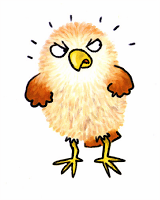 Picture books are hard! (well, good ones are)
Picture books are hard! (well, good ones are)
It's really interesting, reading the wonderful posts on this blog, to discover other authors’ and illustrators’ fascination with the mysterious process that is picture book creation.
I share their fascination. I also share the frustrations and rewards that come with the task of trying to choreograph the delicate dance performed by words and pictures in such a way that the result adds up to more than the sum of its parts. It’s certainly a deeply mysterious bit of chemistry, or possibly an equally mysterious bit of quantum mechanics mixed with a dash of chaos theory. . .
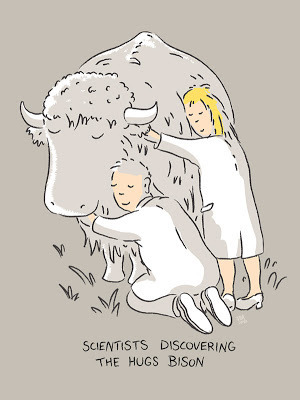
The analogy of a picture book with a piece of music, which James Catchpole posited in an earlier post is a good one. (It struck a chord with me. . . struck a chord. . get it? Oh never mind. .)
My take on it is that a good picture book is like a perfect three chord pop song. Nothing you could add would improve it, and nothing you could take away would improve it. It is perfect as it is in its simplicity. And like a perfect three chord pop song, a good picture book is a hard thing to pull off.
http://www.youtube.com/watch?v=EzJeovAiDKs
OK, more than three chords but the principle still applies ;-)
So, to put my own oar into the mix, as The Poet said (he wasn't a very good poet). . . As an author/illustrator, how do I approach picture book creation? Which comes first in my creative process, words or pictures?
Well, as I’m an illustrator who at first, only took to writing in order to have something to illustrate, (and to get bigger advances, obviously) you might be surprised to hear that in my case pictures don't always come to me first. But when they do, it goes like this -
The process starts with a character, my Potential Picture Book Protagonist. I start to draw him or her to see if that sparks any further inspiration. For me, for it to spark a fully-fledged picture book idea, a character drawing has to have the potential for a story contained within it somehow. I can’t just foist a generic story (even if I could think of one) onto a character. That never works, for me at least, and I've quite often had to drop what I thought were some great visual characters because I couldn't nail down what they would actually do. I couldn't prize a viable story out of them.
I never did know quite what to do with Small Bear here. . .

For me, a story has to emerge from, or become apparent as a kind of by-product of the picture. There has to be a fit. I have to be able to say. “Ah, so that's what was going on!”
This is best explained visually. I saw a great photo of a puffin on a website I was a member of a while back. It was walking along with one leg in the air. I thought it was really funny in an endearing sort of way and had serious children's book character potential.
(I'd post a link here but it's not on that site any more it seems)
So I drew a puffin character in a similar silly-walk sort of pose. Just for fun, I drew him looking out of the corner of his eye as if he had just noticed something happening behind him. He looked slightly pompous and silly, caught in mid stride.
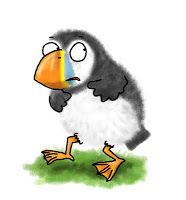
I liked the drawing very much and was sure that there was a story in there somewhere. Nothing came to me straight away so I left it to ferment for a while. I did email it to David Bennett at Boxer Books as he is a visual person and would respond if he liked it. He really liked it, which was encouraging, so I gave the drawing further consideration.
Then, an idea that was funny, had a connection to a child and parent's life experience, (this is important) and that worked really well with the drawing, came into my head.
It was this - The puffin was being followed. Not by something nasty, but by three baby gulls, who were imitating him for a silly game as he set out on his morning walk. This scenario explained puffin’s quizzical backward glance and at the same time allowed his pomposity to play a part, as the baby gulls were busy puncturing it.
“Ah, so that's what was going on!”
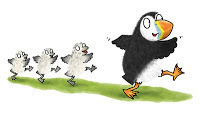
The idea developed into a book called 'Don’t Copy Me!' In which three baby gulls follow Little Puffin around, copying everything he does. The book documents his attempts to get them to stop. (I sent the photographer a copy btw).
But a picture book idea doesn't have to come from a fully formed drawing. I often find that my best ideas involve a character and a scenario, both of which arrive on the same wave of inspiration. Often as more of a concept than as a particular narrative or story. A short phrase can be the trigger, in conjunction with a drawing. The phrase can trigger the idea or loose concept, which immediately gets visualised in my head. From that, a character is drawn, roughly at first, and from that character, the character of the story itself emerges. This can all happen in about ten minutes! Then the real work starts...
My Baby Owl character, the star of my 'I’m Not' series (I’m 'Not Cute!', 'I’m Not Scared' et al) arrived in this way. His sixth book, 'I’m Not Reading!' is out now, folks. . .
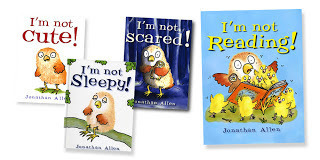
I'll document Baby Owl’s journey from fluffy blob to much loved character for you another time if I'm allowed. I’ve gone on too long as it is. . .
I hope that the above has provided some useful insight into the picture book creation process as pertains to me at least. My approach may resonate with somebody, somewhere anyway. So if you are that somebody, or even if you're not, do let me know your thoughts.
At least you now know that a picture is sometimes worth a thousand words, though three to four hundred, with the action split dynamically over twelve spreads (self ends) is preferable.
Cheers,
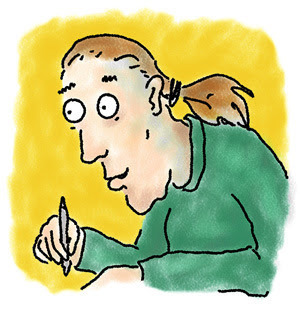 JonathanYou can find out more about guest blogger, Jonathan Allen, at his website and his blog (just click).
JonathanYou can find out more about guest blogger, Jonathan Allen, at his website and his blog (just click).

Yeah right.
I may be preaching to the choir here, but plenty of people confuse simple with easy. And, as any fule know, they are not the same at all.
Being as I am, at the simple, 'cartoony’ end of things illustration style wise, I am perhaps somewhat touchy about this.
 Picture books are hard! (well, good ones are)
Picture books are hard! (well, good ones are)It's really interesting, reading the wonderful posts on this blog, to discover other authors’ and illustrators’ fascination with the mysterious process that is picture book creation.
I share their fascination. I also share the frustrations and rewards that come with the task of trying to choreograph the delicate dance performed by words and pictures in such a way that the result adds up to more than the sum of its parts. It’s certainly a deeply mysterious bit of chemistry, or possibly an equally mysterious bit of quantum mechanics mixed with a dash of chaos theory. . .

The analogy of a picture book with a piece of music, which James Catchpole posited in an earlier post is a good one. (It struck a chord with me. . . struck a chord. . get it? Oh never mind. .)
My take on it is that a good picture book is like a perfect three chord pop song. Nothing you could add would improve it, and nothing you could take away would improve it. It is perfect as it is in its simplicity. And like a perfect three chord pop song, a good picture book is a hard thing to pull off.
http://www.youtube.com/watch?v=EzJeovAiDKs
OK, more than three chords but the principle still applies ;-)
So, to put my own oar into the mix, as The Poet said (he wasn't a very good poet). . . As an author/illustrator, how do I approach picture book creation? Which comes first in my creative process, words or pictures?
Well, as I’m an illustrator who at first, only took to writing in order to have something to illustrate, (and to get bigger advances, obviously) you might be surprised to hear that in my case pictures don't always come to me first. But when they do, it goes like this -
The process starts with a character, my Potential Picture Book Protagonist. I start to draw him or her to see if that sparks any further inspiration. For me, for it to spark a fully-fledged picture book idea, a character drawing has to have the potential for a story contained within it somehow. I can’t just foist a generic story (even if I could think of one) onto a character. That never works, for me at least, and I've quite often had to drop what I thought were some great visual characters because I couldn't nail down what they would actually do. I couldn't prize a viable story out of them.
I never did know quite what to do with Small Bear here. . .

For me, a story has to emerge from, or become apparent as a kind of by-product of the picture. There has to be a fit. I have to be able to say. “Ah, so that's what was going on!”
This is best explained visually. I saw a great photo of a puffin on a website I was a member of a while back. It was walking along with one leg in the air. I thought it was really funny in an endearing sort of way and had serious children's book character potential.
(I'd post a link here but it's not on that site any more it seems)
So I drew a puffin character in a similar silly-walk sort of pose. Just for fun, I drew him looking out of the corner of his eye as if he had just noticed something happening behind him. He looked slightly pompous and silly, caught in mid stride.

I liked the drawing very much and was sure that there was a story in there somewhere. Nothing came to me straight away so I left it to ferment for a while. I did email it to David Bennett at Boxer Books as he is a visual person and would respond if he liked it. He really liked it, which was encouraging, so I gave the drawing further consideration.
Then, an idea that was funny, had a connection to a child and parent's life experience, (this is important) and that worked really well with the drawing, came into my head.
It was this - The puffin was being followed. Not by something nasty, but by three baby gulls, who were imitating him for a silly game as he set out on his morning walk. This scenario explained puffin’s quizzical backward glance and at the same time allowed his pomposity to play a part, as the baby gulls were busy puncturing it.
“Ah, so that's what was going on!”

The idea developed into a book called 'Don’t Copy Me!' In which three baby gulls follow Little Puffin around, copying everything he does. The book documents his attempts to get them to stop. (I sent the photographer a copy btw).
But a picture book idea doesn't have to come from a fully formed drawing. I often find that my best ideas involve a character and a scenario, both of which arrive on the same wave of inspiration. Often as more of a concept than as a particular narrative or story. A short phrase can be the trigger, in conjunction with a drawing. The phrase can trigger the idea or loose concept, which immediately gets visualised in my head. From that, a character is drawn, roughly at first, and from that character, the character of the story itself emerges. This can all happen in about ten minutes! Then the real work starts...
My Baby Owl character, the star of my 'I’m Not' series (I’m 'Not Cute!', 'I’m Not Scared' et al) arrived in this way. His sixth book, 'I’m Not Reading!' is out now, folks. . .

I'll document Baby Owl’s journey from fluffy blob to much loved character for you another time if I'm allowed. I’ve gone on too long as it is. . .
I hope that the above has provided some useful insight into the picture book creation process as pertains to me at least. My approach may resonate with somebody, somewhere anyway. So if you are that somebody, or even if you're not, do let me know your thoughts.
At least you now know that a picture is sometimes worth a thousand words, though three to four hundred, with the action split dynamically over twelve spreads (self ends) is preferable.
Cheers,
 JonathanYou can find out more about guest blogger, Jonathan Allen, at his website and his blog (just click).
JonathanYou can find out more about guest blogger, Jonathan Allen, at his website and his blog (just click).
Published on March 31, 2013 00:00



